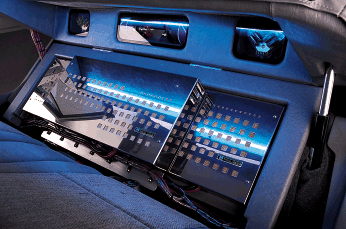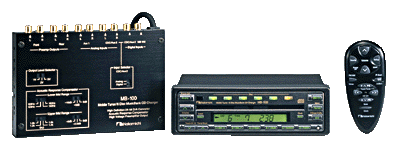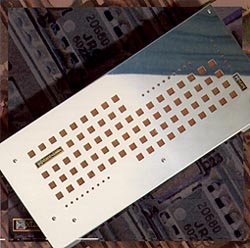Looking for Mr. Goodcar
“When it comes to amplifiers, strange as it seems, America makes the best ones. The Japanese are starting to catch up, but the US still puts out the best amps.”
Perhaps this isn’t the most auspicious way to start off my career here at StereoTimes, but fame and fortune awaits me in the world high-end reviewing. So here goes…
 In one of my first emails to Clement, I foolishly mentioned that I have what I consider to be a damn good car stereo. His suggestion was that I write about it. I actually had my heart set on reviewing a set of Krell monoblocks, but hey, I’m willing to put in my chops. Actually, it was either this or the Bose Wave radio.
In one of my first emails to Clement, I foolishly mentioned that I have what I consider to be a damn good car stereo. His suggestion was that I write about it. I actually had my heart set on reviewing a set of Krell monoblocks, but hey, I’m willing to put in my chops. Actually, it was either this or the Bose Wave radio.
First off, let’s get a few things out of the way: I wear my baseball cap brim-forward; the crotch of my pants rides higher than my knees; and I rarely, if ever, use the word “booty” in conversation. In fact, I consider myself a dyed-in–the-wool audiophile. I spin only vinyl at home and use an all-tube system driving Magneplanars. I also have a serious cable addiction that I’m trying desperately to kick.
I was interested in audio before I had a license. Since I started smoking pot at 17 years of age, music has always been an integral part of my life. And even after I quit that habit (pot), the audio Jones has remained with me. I also love cars, so the mix of music and autos seems natural to me.
Audiophiles and car stereos. Now there’s a fine mix. I’m sure that many of you remember the outrage that Wes Phillips’ column, “Car Tunes” elicited when he wrote about his car audio odyssey in Stereophile – many “cancel my subscription” letters were printed in successive issues. I see a distinct polarization among audiophiles: the ones who drive light-blue K cars or babyshit brown Volvos just don’t seem to “get it”.
For those of you who may not have followed Wes’ column, I’d like to sum it up for you here:
-
Wes tries to install Audio Alchemy gear in his car and fails miserably.
-
Wes tries to upgrade his charging system and fails miserably.
-
Wes tries to eliminate a ground loop (resulting in nasty hum) and fails miserably over the course of four issues.
-
Wes buys lots of equipment based upon manufacturers’ recommendations and never ends up with what he considers high-end sound.
Wes is one of my favorite journalists, and I don’t want to slam him here, but his column did nothing to promote car audio to the readers of Stereophile. His approach was haphazard: He added component after component, never following a sensible upgrade path. He’d listen to manufacturers and attempt to shoehorn in gear that was totally unsuited to his needs. I’m not surprised that he was never truly satisfied with his system. What Wes did, in fact, was approach upgrading his car stereo just like many non-audiophiles approach home hi-fi.
Well I’m here, hopefully, to stop you from going that route.
What I’d like to do is walk you though my system as it sits right now, and describe how I chose each part. If, at the end, you’re still reading, hopefully you’ll email me some feedback asking that I either cease and desist or write more articles based upon your needs and interests.
Let’s start at the front end. As all audiofools know, the source of the signal is of paramount importance. Anyone who’s reading this is probably of the opinion that a lousy source will result in lousy sound, no matter what amps and speakers follow it up. Well, ladies and gents, the same thing goes for car audio.
I know, there’s a higher noise floor and all of the details are going to be drowned out. But that isn’t the whole story here, folks. Fatiguing treble from harsh DACs will carry right through road howl, and this detraction tends to be exacerbated by the higher volumes you’ll tend to listen at while on the road. It also turns out that you can hear through the noise floor, somewhat like detail that’s buried below surface noise and tape hiss. All of this makes a good deck worthwhile in the mobile environment.
So what makes a good head unit? In my opinion, simplicity is best. A friend of mine, Colin Kay, owns a high-end car stereo store here in Toronto. Autoworks does some fairly exotic installations: Colin’s Corvette has a Sonic Frontiers Transdac and Jitterbug housed in some incredibly extravagant custom work. But that’s a show car and for us simple consumers, Colin would say, simpler is better.
Colin is a true audiophile, and I’ve got him to thank for drawing me into the world of high-end audio. Much of his clientele, though, is hat-on-backward baggy-panted hip-hoppers, and I get a charge out of watching him deal with kids who want him to install systems consisting of 1000 watts’ worth of bass, with a front stage consisting of Rat Shack supertweeters glued to the dashboard. He’ll do it, but you can see him grinding his teeth to paste. Lights, buttons, and dancing equalizers on head units seem to sell well too.

Nakamichi makes some wonderful sounding, solidly built head units. I have an MB-100 in-dash 6-pack CD changer with external preamp and 24 bit DAC. This is a fairly expensive unit. It has no flashing lights, no dancing graphic equalizers, and it most certainly lacks the remote controlled, automatically retracting 6-inch video screen that Colin’s currently installing in an outrageous Z28 along with 4 15″ subwoofers driven by 2400 watts. Can’t you just smell the testosterone?
While there’s no way that you’re going to be able to avoid bass and treble controls – heck, you’re gonna be stuck with a loudness button whether you like it or not – try to get a deck without built-in amplification. This isn’t as easy as it seems. Just like in home audio, where a preamp with only volume and selector is more expensive than a receiver with a million buttons, knobs and lights, car audio decks that are preamp-only will be more expensive than their powered brethren.
Besides the MB-100, Nakamichi also makes a single CD player with an 18 bit DAC that is quite reasonably priced. I’ve heard it, and it also sounds very good. Unfortunately, it has built-in amplification. There’s a million ways to skin a cat, and I’m sure that many other companies make good sounding decks. But as with home gear, avoid frills, lights, and extraneous buttons if possible Denon makes some decks that fit the bill, but I haven’t heard them myself.
From the deck, the signal has to travel to an amplifier. Any good store will roll their own interconnects. You can go crazy and use home cables, but remember that the car environment is most unfriendly to low-level signals, and you may end up with a vicious hum that’ll drive you witless. This is an area where you may want to follow the advice of the installer. Compromise and insist on WBT RCA’s if you’re feeling exposed here.
When it comes to amplifiers, strange as it seems, America makes the best ones. The Japanese are starting to catch up, but the US still puts out the best amps. Again, there are tons of different amplifier companies, and many of them put out a good product. Just make certain that you avoid Kenwood, Sony, Pioneer, and the like. Many of the lower end companies rate their amps at “maximum” watts. 300 watts max is more like 50 watts from a respectable company. Car amps tend to be rated at 4 ohms, and a good one will double its power into 2 ohms. Really good ones will double it again into 1 ohm. In my last car, I had an amplifier made by Soundstream that was rated at 50 wpc into 4 ohms, and would put out 600 watts into ½ ohm mono. How you ask? Beats me, but it was chock full of transistors and big caps, and had huge traces on the circuit board.
If you want a fairly simple system, the easiest way to go is to buy a good 4 channel amp and bridge two of the channels in order to power the subwoofer. 4 channel amps usually have onboard crossovers which is a good idea in order to decrease the complexity further. Active crossovers and bi-amping are de rigeur in mobile audio, as passive crossovers between subs and satellites don’t have the flexibility that’s required in the small confines of a car.
 In my car I currently have an Xtant 3300, which is a flexible 3 channel amp that is seriously underrated at 65 watts to the two front channels and 300 watts to the subwoofer. It also has a beautiful stainless steel chassis that is very big on the ooh-ahh factor. Xtant makes a very smooth sounding amp, and the on-board crossover is expandable to 24db/octave, which helps keep all of the midrange out of the subwoofers.
In my car I currently have an Xtant 3300, which is a flexible 3 channel amp that is seriously underrated at 65 watts to the two front channels and 300 watts to the subwoofer. It also has a beautiful stainless steel chassis that is very big on the ooh-ahh factor. Xtant makes a very smooth sounding amp, and the on-board crossover is expandable to 24db/octave, which helps keep all of the midrange out of the subwoofers.
But let’s face it, audio’s all about MORE BOXES! We don’t have separate amps, preamps, DACs, and phono stages because they sound better. We have them because they’re sooo cool. So if you want to go whole hog on your car system, you need an amp for each speaker, a crossover to split the signals, and heck, why not slap in a quasi-parametric equalizer just for the shopping fun.
But whatever you do, make certain that you get a subwoofer (or 4!) designed for a sealed box. This is really the only practical way to get linear, deep, accurate bass. One 10″ subwoofer can be installed in a box that will only take up 1 cubic foot of space. That’s small, folks. And that one sub, powered by 200 watts, will give out satisfying, tight bass. This is thanks to “cabin gain” the small enclosure of a car will compound low bass notes, giving you 10-15db of increased output, as compared to free-air, at 30hz. That’s why the Z28 with the 4 15″ subs will be able to put out 150db at 25 Hz. Just remember that you’ve got Colin to thank when you’re woken up at 3am thinking that you’re being targeted by artillery.
 I have 2 JL Audio 10w6 subwoofers in a small sealed box in the trunk of my Jetta. These subwoofers show the Xtant amplifier a 3-ohm mono load, which means that each sub is receiving about 200 watts. With this setup, I get tremendous low end that far surpasses my home system. It’s tight, authoritative, and yes, it’s loud when I want it to be. In my old Jeep Grand Cherokee, I had 3 of these subs. In that vehicle, with 600 watts (1 ohm, mono load!) when I cranked it up with some bass-heavy music it felt like I was going to have an embolism. But circumstances dictated a downsizing, yet I don’t feel any lack with only two of these monster subwoofers. I highly recommend them.
I have 2 JL Audio 10w6 subwoofers in a small sealed box in the trunk of my Jetta. These subwoofers show the Xtant amplifier a 3-ohm mono load, which means that each sub is receiving about 200 watts. With this setup, I get tremendous low end that far surpasses my home system. It’s tight, authoritative, and yes, it’s loud when I want it to be. In my old Jeep Grand Cherokee, I had 3 of these subs. In that vehicle, with 600 watts (1 ohm, mono load!) when I cranked it up with some bass-heavy music it felt like I was going to have an embolism. But circumstances dictated a downsizing, yet I don’t feel any lack with only two of these monster subwoofers. I highly recommend them.
Front speakers can be very tricky. While there are some objective parameters that you can use to choose amps and head units, nothing is going to be more subjective than your choice of speakers. I personally can’t stand MB Quart speakers, as I find them bright enough to strip paint. But many people absolutely love them. My personal favorites are made by Oz Audio. These separates (5″ or 6″ midbass, 1″ tweeter and passive crossover) use a soft dome tweeter. The surround is rubber, which I personally like for a mobile environment. These speakers image superbly and have a subdued treble that I find quite soothing. As I said before, I listen at higher levels in the car, and a rising top-end tends to irritate me. With the Oz speakers, I can have the volume fairly high and still hold a conversation.
If at all possible, you want to get a 6″ midbass in the doors. This may necessitate some custom work, but hey, there are sacrifices to be made. If your car is leased, you may have to make do with 5″ This is going to be vehicle dependent and your installer can help you here. Mount the separate tweeters as close to the mids as possible, preferably as far away from your ears as you can, as this tends to minimize the difference in distance from the tweeters to your ears. Don’t mount them on the dash, as imaging will suffer. Don’t glue them to the windshield or rear view mirror either.
Finally, if you’re in the process of choosing an installer/shop, try this skill-testing question: Ask him what type of power and ground wire he’ll use for the amps, and where he’ll fuse them.. If he suggests anything smaller than 4 gauge, and recommends putting the fuse anywhere other than within 12″ of the battery, back slowly away and thank him for his time.
There’s much more that goes into a high-end car system that the bits and pieces that I’ve related here. I could go on about capacitors for auxiliary energy storage, equalization, mass dampening of resonating panels and box construction ad infinitum. But I’d really like to sum up this (far too long) article by saying that if you love music, stereos and cars, you owe it to yourself to delve into the world of mobile audio. It’s possible to build a satisfying system for less than the price of a good home DAC. True, this system wouldn’t be quite as good as a high-end home system, but that’s what the upgrade bug is for, right?
One thought on "Looking for Mr. Goodcar"
Leave a Reply
Stereo Times Masthead
Publisher/Founder
Clement Perry
Editor
Dave Thomas
Senior Editors
Frank Alles, Mike Girardi, Russell Lichter, Terry London, Moreno Mitchell, Paul Szabady, Bill Wells, Mike Wright, and Stephen Yan,
Current Contributors
David Abramson, Tim Barrall, Dave Allison, Ron Cook, Lewis Dardick, John Hoffman, Dan Secula, Don Shaulis, Greg Simmons, Eric Teh, Greg Voth, Richard Willie, Ed Van Winkle, Rob Dockery, Richard Doron, and Daveed Turek
Site Management Clement Perry
Ad Designer: Martin Perry





What happened to Autoworks and Colin Kay??